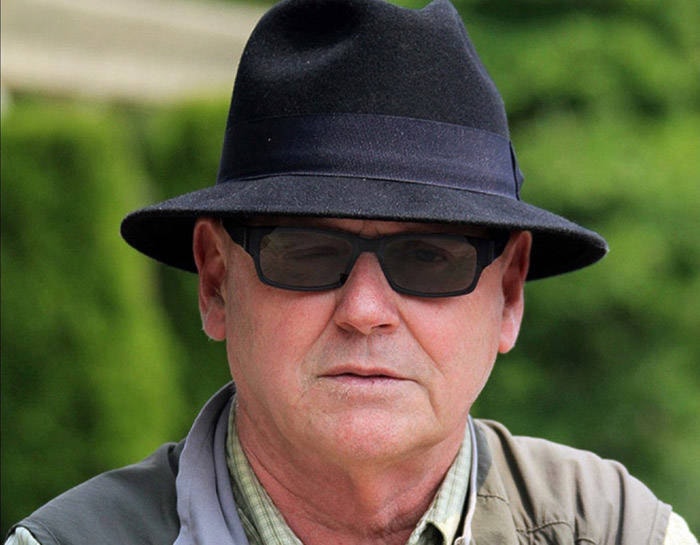When you know trees experience pain, you can no longer disrupt their lives with large machines – The Hidden Life of Trees, Peters Wholleben.
Friday, Jan. 25th. I’d set off to hike in Golden Ears park, but a Load King flat-bed truck carrying cement construction blocks changed my plans. It filled the lane in front of me as we came off 232nd Street onto Fern Crescent.
Opposite the Eagles Hall at 132nd Avenue, the end of the trailer jolted right, side-swiping a big Douglas fir at the edge of the road.
Chips flew from the trunk as solid metal made contact. I winced as if I’d bumped my scabbed elbow, and again, when the trailer clipped another tree, seconds later.
Between 132nd and 136th avenues, old firs line the narrow S-curve. Four wear battle scars from passing vehicles. I wondered if drivers gave any thought to the trees afterwards.
In 2017, when Maple Ridge suggested taking some out to realign the road, 2,900 people signed a petition against any changes.
Many, such as the life-long forester Wholleben, believe trees have feelings that should be considered before we decide their fate.
Doug Stanger, who lives near here, says: “People drive too fast. This is the only traffic calming section.”
Good argument for signage asking motorists to slow down for the trees, for insisting big loads be preceded by pilot cars. They could use some of the left lane in tight spots.
The flatbed turned up 136th to a condo development. Don Fitzgerald is its site foreman. I explained the local significance of the old firs. Maybe, Don could help prevent further damage.
“I can’t tell my drivers how to drive,” was his initial response, but he saw the problem the narrow road poses, even for a pick-up like the one he drives.
Don said he prefers Larch Avenue and Balsam Street to Fern Crescent as an alternate route. While we chatted, I called staff at Maple Ridge city hall who look after the environment. When I got “leave a message,” I asked for someone to attend the site.
“I’ll wait,” I said.
Biologist Mike Pym joined me in 20 minutes. He said he’d ask city arborist Gail Szostek to assess the health of the tree I saw swiped. I left him to talk with Fitzgerald.
Later, he emailed: “In speaking with the site foreman, I insisted that they speak with their drivers and if they feel that the road is difficult to navigate then they should request an alternate route to the site. The foreman agreed.”
On Monday, Szostek called: “The damage is superficial as it is scraping an area of thick wound wood on that one tree which has developed after multiple interactions with passing vehicles. The new scrape exposes wood that does not in any way affect the structural integrity or the health of this tree.”
But if damage continued, would staff eventually say it had to come down for public safety?
“That’s likely to happen without mitigation of some kind,” Szostek said.
“I’m sure it will be hit again, and that one tree will have to go. That’s the plan; to cut it to the stump.”
Wholleben says: “There’s nothing worse for a tree,” than damage under the bark, in its sensitive cambium layer. Fungal spores “will begin their destructive work.”
But damaged trees will attempt to “seal their wound,” Wholleben says, while neighboring trees – the forest is a community – support it by sharing water and nutrients. They know their damaged neighbours – like people – can contribute to their community.
While responsible countries scramble to reduce greenhouse gases, (Canada needs to do better) every living tree helps by storing up to 22 tonnes of carbon dioxide. Wounded trees don’t have to end up as stumps.
Pym’s decision to talk to Fitzgerald shows what can be done with thoughtful intervention.
Anyone who favours this approach will get a chance to say so soon.
City engineer David Pollock says the public will be given options for managing the traffic along this Fern Crescent before decisions are made.
They include pushing 132nd Ave. through to 136th, allowing traffic to avoid the S-curve all together, as would reconfiguring Fern Crescent nearby at the Wild Play recreation site and dog park.
Possibilities also include straightening and widening the S-curve by taking out trees, the original, unpopular idea. The City plans a bridge across the Alouette at 240th and Fern. Traffic would access Abernathy Way using that crossing instead of the slower route pass the S-curve to 232nd. When you know trees feel pain, you find ways to save them.
Jack Emberly is a retired teacher, local
author and environmentalist.
